a fons - Barcelona històric
2. In depth
University and city, a symbiosis in constant transformation
Throughout its history, the UPF has always been committed to the urban rehabilitation and revitalization of various areas of Barcelona
Click on the map for more information:
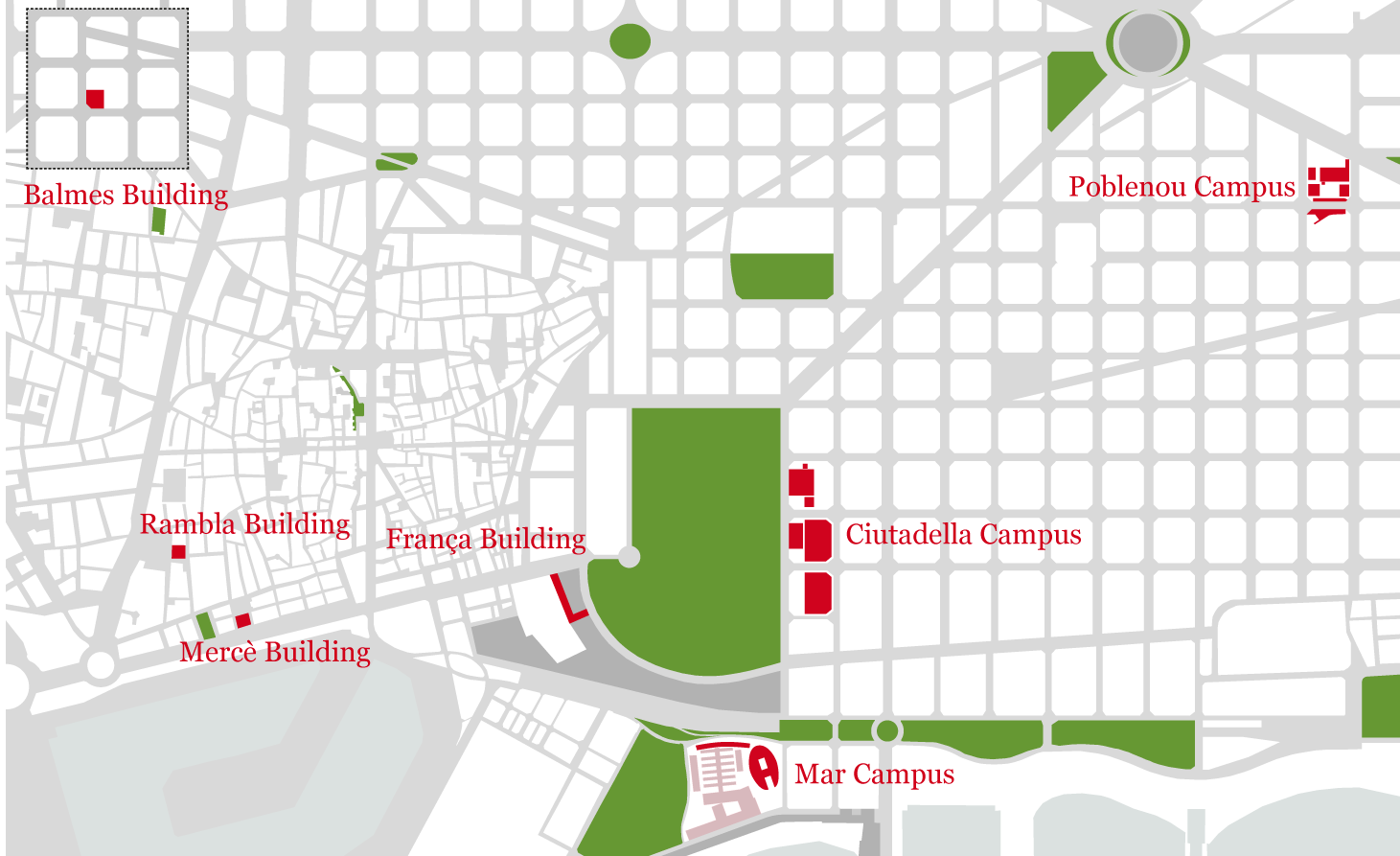
Balmes Building
Architect: Enric Sagnier, 1927
Refurbishment and new construction: Josep Benedito and Jaume Llobet, 1990 and 1991
First year of university use: 1990
First studies housed: Law and Economic and Business Sciences
Rambla Building
Architect: Juli Marial i Tey, 1879
Refurbishment and new construction: Josep Benedito and Jaume Llobet, 1991 and 1992
First year of university use: 1991
First studies housed: Public Management and Administration (GAP) and Business Sciences
Change of use: Elisava School, affiliated to UPF (2009)
Mercè Building
Architects: Josep Vilar, 1838, and Josep Nolla, 1851
Refurbishment: Josep Benedito and Jaume Llobet, 1993 (Mercè, 12) and 1994 (Mercè, 10).
First university uses: Rector’s Office, IUHJVV, Economic Council
França Building
Architects: Pedro Muguruza, Raimon Duran and Pelai Martínez, 1929
Refurbishment: Josep Benedito and Jaume Llobet, 1993
First studies housed: Labour Relations, 1993
Last year of university use: 2008
Buildings and areas on the Ciutadella Campus
Jaume I Building
Architect: Saturnino Rueda, 1888
Refurbishment: Esteve Bonell and Josep M. Gil, 1996
Prizes: City of Barcelona Architecture and Urban Design Prize 1996
Jordi Rubió i Balaguer Agora
Architects: Jordi Garcés and Enric Sòria, 1996
Prizes: City of Barcelona Architecture and Urban Design Prize 1996
Roger de Llúria Building
Architect: Saturnino Rueda, 1888
Refurbishment: MBM Arquitectes (Josep Martorell, Oriol Bohigas and David Mackay), 2000
Prizes: City of Barcelona Architecture and Urban Design Prize 2001
First studies on the Ciutadella Campus: Humanities, Business Management and Administration, Business Sciences, Public Management and Administration, Labour Relations, Law, Political Sciences, Labour Sciences and East Asian Studies
Dipòsit de les Aigües
Architect: Josep Fontserè, 1884
Refurbishment: Lluís Clotet and Ignasi Paricio, 1999
Mercè Rodoreda Building
Architect: Juan Navarro Baldeweg, 2008 and 2015
Buildings on the Mar Campus
Doctor Aiguader Building
Architects: Carles Buixadó and Joan Margarit, 1991
Refurbishment: Josep Benedito, Frederic Crespo and Ramon Valls, 1998
First studies housed: Human Biology, 1998-1999 academic year
Barcelona Biomedical Research Park (PRBB)
Architects: Manuel Brulet and Albert de Pineda, 2006
Prizes: FAD Opinion Prize for Architecture 2007
Buildings and areas on the Poblenou Campus
La Fàbrica and La Nau Buildings
Architect: Josep Marimon i Cot, 1877
Reinforcement: Antoni Vilanova and Eduard Simó, 2005
Refurbishing: Josep Benedito and Ramon Valls, 2009
Roc Boronat Building and Plaça Gutenberg
Architects: Josep Benedito and Ramon Valls, 2009
Tallers Area (Imagina)
Architects: Carles Ferrater and Patrick Genard, 2009
(The city block as a whole was awarded the City of Barcelona Architecture and Urban Design Prize 2008)
Tànger Building
Architect: Frederic Crespo, 2009
UPF is a modern public university with three campuses located in the centre of the city of Barcelona. The commitment to an institution with an urban focus, which was planned in earnest by the first rector, Enric Argullol, spelt a return to a traditional university model, characteristic of continental Europe, of being situated in city centres. At the same time it went against the Anglo-Saxon model of locating facilities in the outskirts, which had gained force with the socialisation of university education throughout the 20th century.
Courtyard of the Jaume I building. Luis Tasso's instant photography collection, 1890 /
Courtyard of the Jaume I building. Nowadays
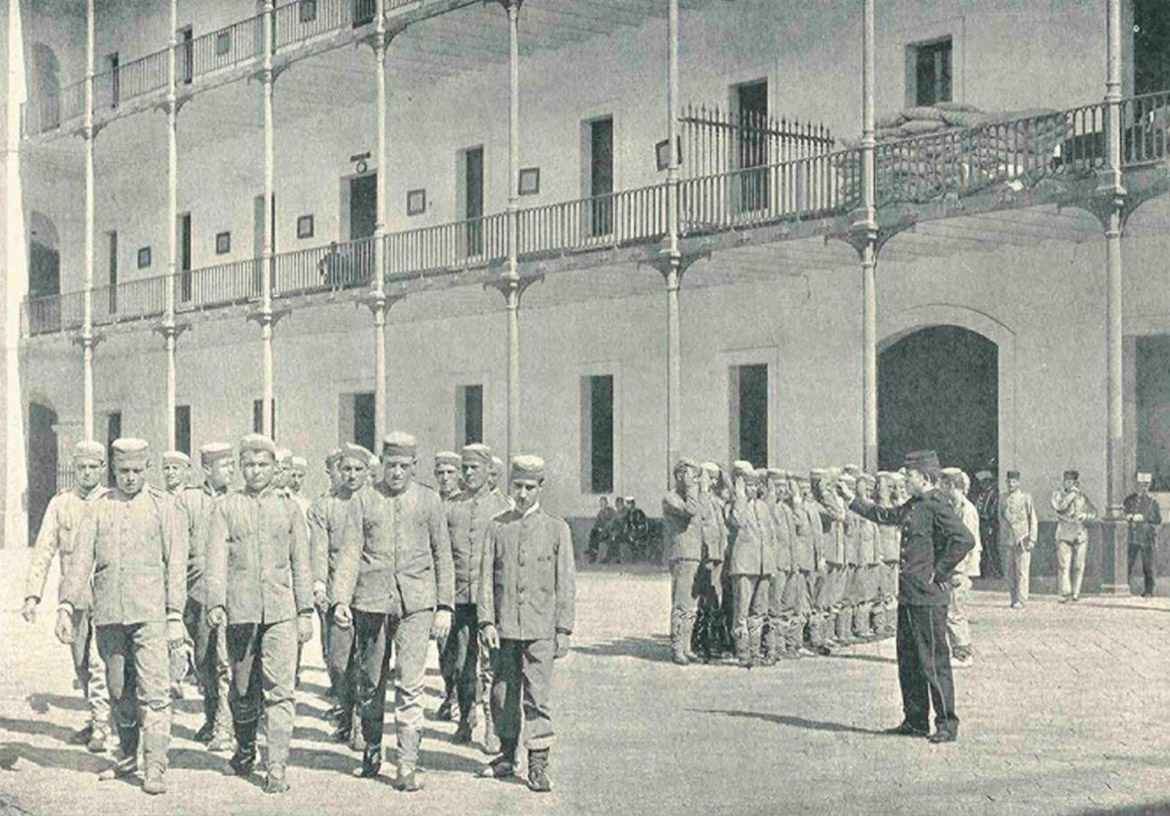
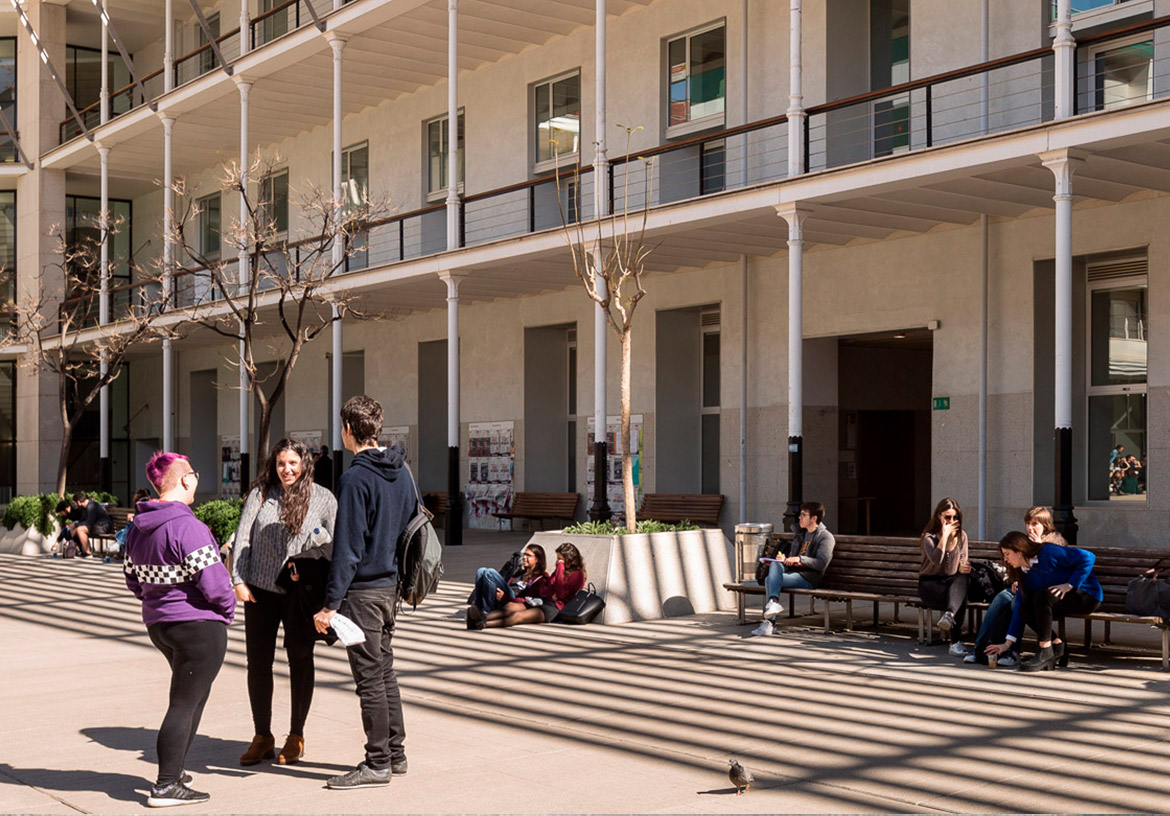
Ever since UPF was set up, more than 27 years ago, the University’s commitment to the city has been reflected from an urban design point of view, as the progressive implementation of the campuses has favoured the rehabilitation of several neighbourhoods and areas of the Catalan capital. These interventions have always been carried out with great care and architectural consideration, safeguarding heritage conservation, and have merited several architecture and urban design awards.
The history of the campus buildings is a chronicle of the evolution of Barcelona, straddling the 19th, 20th and 21st centuries
The rescue of Ciutat Vella and the opening up of the city to the sea in the 1990s, with the Olympic Games; the conception of knowledge creation and transfer nodes, with the Poblenou Campus facilities in the 22@ innovation district, and UPF Research Park, in the Ciutadella; or the scientific cooperation established with the location of the Mar Campus in the neighbourhood of Barceloneta, constitute the best examples of this transformation and connection with the University’s surroundings.
This foundational goal also looks forward towards the future, as is reflected in the Pompeu Fabra University Strategic Plan 2016-2025, which states that “UPF has the mission to promote innovation, social, political and economic transformation and to generate synergies with society, in order to contribute to social welfare and create value.” This includes urban design, a field in which the University has always been in close liaison with the authorities of Barcelona and Catalonia with a view to helping to transform those areas of the city that were candidates for regeneration.
The history of the campus buildings is a chronicle of the evolution of Barcelona, straddling the 19th, 20th and 21st centuries. It is also the history of UPF’s commitment to the revitalisation of Barcelona’s neighbourhoods, through the injection of vitality and dynamism that university life brings to areas where it takes root. The advantages that this model spells, for the city and the institution alike, stand as proof of the merits of the initial urban approach.
Balmes Building: The early years in the heart of the Eixample
The Balmes Building was the first to host UPF students. To be exact, 316 school leavers who had enrolled for the Degrees in Law and Economic and Business Sciences started their studies in October 1990 in the building located at number 132, Carrer Balmes, formerly the premises of Pi i Margall Secondary School and subsequently Fòrum Vergés, which was adapted to university use over a period of six months.. A year later, in 1991, the university facilities were extended, with a new building at number 134, Carrer Balmes. The UPF Library, initially located in Balmes, 132, moved to this. Today this building houses the UPF Barcelona School of Management (UPF-BSM), formerly IDEC.
Rambla Building: A shake-up to revitalise a depressed area
In order to expand the facilities, since the Balmes Building was too small to house new students and degrees, UPF decided to move into the Rambla, a personal decision by the Rector, Enric Argullol, that was given the go-ahead by the City Council and the Catalan Government and meant that the University remained definitively in Barcelona.
The arrival of UPF at the bottom of the Rambla was an event of great significance in urban development terms, representing a clear shake-up for that part of the city. It served to rescue the area, traditionally associated with prostitution and drugs, and contributed decisively to the process of urban renovation and social transformation of the old city centre, started up some years earlier by the City Council.
The arrival of UPF at the bottom of the Rambla was an event of great significance in urban development terms
In 1991, the University carried out a comprehensive refurbishment of the building at number 32 of the Rambla, the former Grand Hotel Falcón; a year later, a new building was erected at number 30 and the two properties were combined, together with a series of buildings in Carrer del Gínjol, later. With the new construction, this old street was annulled and in its place Plaça Joaquim Xirau was created.
Mercè Building: The Rector’s Office moves to Ciutat Vella
In March 1993 the University moved into the Mercè Building (number 12, Carrer Mercè), which it had refurbished to make it into the Rector’s Office, originally located in a detached house in Carrer Marc Aureli, in the neighbourhood of Sant Gervasi. In addition to the Rector’s Office, the building housed the Economic Council, a number of central administrative services, the headquarters of the Jaume Vicens i Vives University Institute of History (IUHJVV) and your library, on the ground floor. A year later, in 1994, number 10 of Carrer Mercè was inaugurated and numbers 10 and 12 were merged into a single property.
The building number 12 formed part of an urban declassification plan, and was scheduled to be demolished
Number 10 had been acquired by a private company, while in 1991 the Ministry of Defence returned number 12 to the City Council, which guaranteed the construction by means of a special plan for educational facilities. The building formed part of an urban declassification plan, and was scheduled to be demolished to improve access to the basilica via Carrer Boltres. The new Plaça de la Mercè dated from 1981, when the block of buildings in front of the basilica was demolished to open up Ciutat Vella.
Plaça de la Mercè. Demolition of the block of houses in front of the basilica. Anonymous, 1981 /
Plaça de la Mercè. Nowadays
França Building: The University hand in hand with the railway station
The França Building came to form part of the urban imagery of UPF as of 1993, when it was incorporated into what the Rector, Enric Argullol, called the “High Street of UPF”, a line that passed through the old Ciutadella barracks, the Rector’s Office in the Mercè Building and the Rambla Building. This was made possible by a leasing agreement with the state railway company RENFE, through its chairwoman, Mercè Sala, who later became president of the Board of Trustees of the University.
Initially UPF occupied 11,000 square metres of the north wing of the station, with a 75-year surface rights agreement. Two years later, in 1995, the space was extended with another 4,000 square metres, in the south wing. The refurbishment work for university use was done at top speed: the agreement was signed in April 1993, and the first year of the new Degree in Labour Relations was scheduled to start in September the same year. UPF was present in the França building until December 2008, when all its facilities moved to the new Poblenou campus.
Ciutadella Campus: From barracks and a reservoir to university facilities
On 13 February 1992, the three-way negotiations between the City Council, the Catalan Government and the Spanish Government culminated in the definitive transfer of the barracks and their outbuildings from the Ministry of Defence to the Catalan Government, and from the Catalan Government to UPF. Thus, with the signing of an agreement in a tent in the middle of the parade ground of the Jaume I barracks, the strategic nature of the creation of the new institution was made to prevail.
The location of the University in the Ciutadella (the building work to transform the former barracks into university facilities started in August 1992, straight after the Olympic Games) was very positive for the success of the operation of the Olympic district that had been designed by architect Oriol Bohigas, father of contemporary Barcelona urban design. The new campus, the purpose of which was to house the studies associated with the social and human sciences, came to act as an urban link between Ciutat Vella and the new neighbourhood that was being built beside the sea.
The new campus came to act as an urban link between Ciutat Vella and the new neighbourhood that was being built beside the sea
The City Council and UPF signed an agreement to deploy the University in July 1992, and three years later the situation of the buildings was formalised in urban development terms through the Ciutadella Area Special Plan. Since then, the planning of the campus has been governed by this plan, which set forth the preservation of the buildings with most heritage value, the creation of a connecting area between the barracks (now the agora) and new buildings on the plots that became vacant in the military housing area, in Carrer Wellington.
In September 1992, UPF acquired the Dipòsit de les Aigües, which was to become the Main Library (and made it possible to create an underground connection with the Jaume I Building); the University bought the former Municipal Laboratory from the City Council and obtained 75-year surface rights over the Old Fish Market, which was fitted out as a public car park pending development. This brought the total surface area devoted to university uses and facilities up to 69,000 square metres, equivalent to four Cerdà Plan Eixample blocks.
How does the Ciutadella campus sound currently?
A campus that has evolved with refurbishments and new constructions
The two refurbished barracks – the Jaume I and Roger de Llúria Buildings – were devoted to military use uninterruptedly for nearly a century. They were built by the City Council in the late 19th century by way of compensation for the transfer of the old military citadel to the city, and have a structure consisting of two central courtyards lined by three-storey buildings. With their new use, some 3,000 students began to frequent facilities where, a few decades earlier, the fathers of many of them had been issued with their regulation rucksack before being sent away for military service.
The Dipòsit is one of the most unique buildings of the city’s historical and architectural heritage
The Dipòsit de les Aigües was designed in 1874 by the architect Josep Fontserè, with structural calculations by a young Antoni Gaudí, for the purpose of supplying water to the monumental waterfall in nearby Ciutadella Park. It is one of the most unique buildings of the city’s historical and architectural heritage, and now forms part of the UPF Art Track cultural circuit. It comprises a series of parallel semicircular arches 14 metres high with barrel vaults, extending 65 metres in depth. Before it was refurbished as the UPF library, it had such widely varying uses as a municipal poorhouse, a storehouse for the fire brigade and a documentary repository for the law courts.
Interior of the Dipòsit de les Aigües building. 6th of January 1908. Frederic Ballell, Barcelona Photography Archives /
Interior of the Dipòsit de les Aigües building. Nowadays
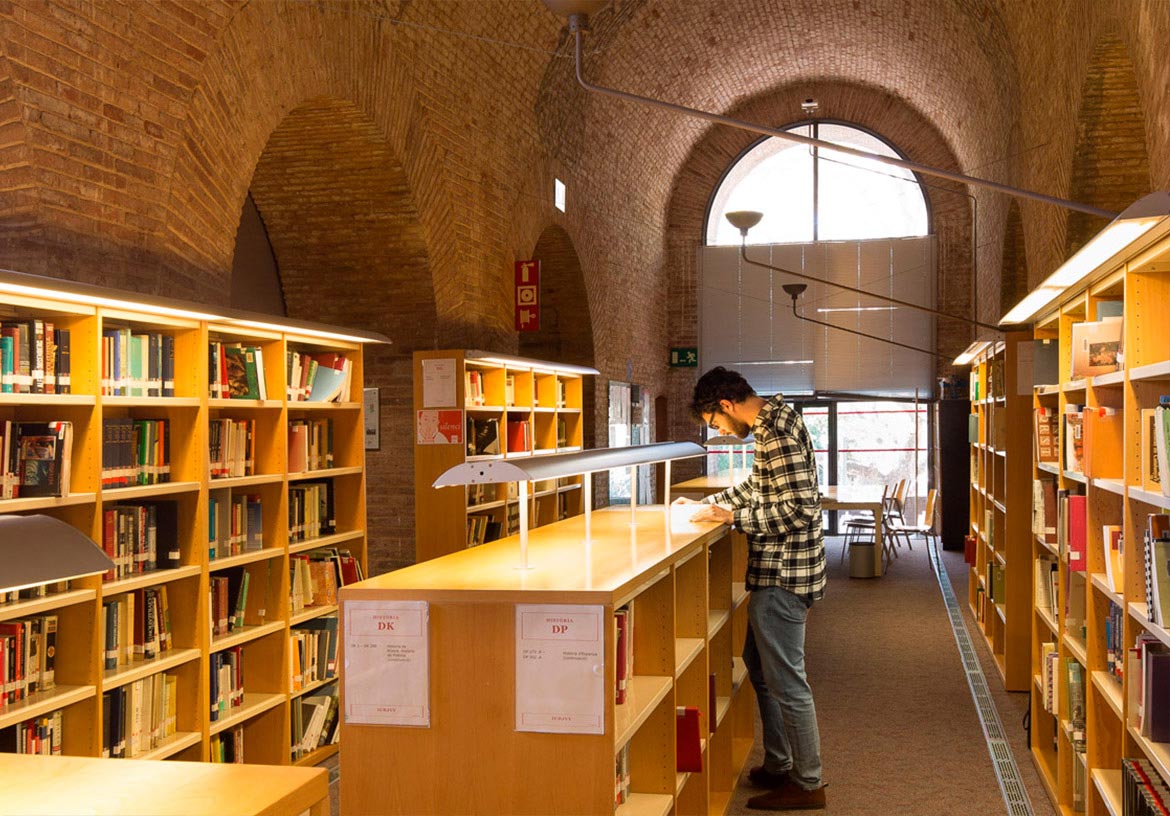
Over the years the social and human sciences campus has been added to with several more elements in the area of Ciutadella Park. These were, in chronological order: the UPF-affiliated ESCI school, in Born Building, which opened in 1998, and RESA student residence, inaugurated in 2001, both in Passeig Pujades; the buildings at numbers 23 and 24 of Carrer Mercè Rodoreda (inaugurated in 2008 and 2014 respectively), dedicated basically to research, and the BarcelonaBeta Brain Research Center, belonging to the Pasqual Maragall Foundation (2016), which consists of three buildings on a plot originally occupied by military housing in Carrer Wellington.
Mar Campus: Teaching and biomedical research on the sea front
The University entered the field of health and life sciences thanks to the authorisation given by the Catalan Government to offer the studies of Human Biology, in the 1998-1999 academic year. UPF moved into the Doctor Aiguader Building, in the working-class neighbourhood of Barceloneta, on the sea front. The building, which had been built in 1991, located next to the Ronda Litoral, completed the Hospital del Mar social and healthcare complex.
The PRBB Building will form part of one of the leading biomedical research centres in southern Europe
Through an agreement with Barcelona City Council, through the Municipal Healthcare Institute (IMAS), UPF was given use of 2,600 square metres of the Doctor Aiguader Building for a period of 30 years. Once refurbished for its new use, in September 1998 the University moved in and gradually occupied the different areas. In the 2008-2009 academic year UPF began, in conjunction with the Autonomous University of Barcelona, to teach the Degree in Medicine, thus satisfying a historical demand of the University.
Seaside front. Picture of the Maritime Section of the 1888 Universal Exhibition. Aerial take /
Seaside front. Nowadays
Some years earlier (2006), an initiative by the Catalan Government, Barcelona City Council and UPF resulted in the construction of the building for the Barcelona Biomedical Research Park (PRBB), which will form part of one of the leading biomedical research centres in southern Europe. The cone-shaped building has an elliptical ground plan, measuring 117 metres in length and 74 in height, and has become a new architectural icon. With a structure designed to meet the needs of the resident centres and create scientific synergies, the building is set in a new public space, Plaça Charles Darwin, a popular spot for locals and tourists alike.
How does the Mar campus sound currently?
Poblenou Campus: Ca l’Aranyó, an icon of industrial architecture in the midst of the 22@ district
In the heart of the neighbourhood of Poblenou, in one of the spaces that is undergoing most urban transformation in the whole of Europe, UPF decided to install the Poblenou Campus, focusing on the fields of communication, technology and languages. Rector Rosa M. Virós agreed with the Barcelona City Hall the move to the new campus. Later on rector Josep Joan Moreso executed its development. Initially all the studies and research that was conducted in the Rambla and França buildings were moved to Poblenou, and academic activity started on 7 January 2009.
Its definitive configuration brought about one of the new knowledge clusters, linked to the 22@ project, which was engaged in transforming the former industrial fabric of Poblenou into the city’s new technology district, characterised by the fostering of synergies. The University, in conjunction with Barcelona City Council and Mediapro Group, came to form part of Barcelona Media Park, a benchmark centre in the communication and audiovisual production sector.
UPF occupied the former industrial complex of Ca l’Aranyó, built in the 1870s following the models of the Manchester school. The ground plan respected the pattern set down by the Cerdà Plan (it was the first factory in Poblenou to follow the Barcelona engineer’s urban grid system) even though it stood in the neighbouring municipality of Sant Martí de Provençals.
Ca l’Aranyó is a unique case among Catalonia’s industrial buildings, as it features two different models
Ca l’Aranyó is a unique case among Catalonia’s industrial buildings, as it features two different models: the construction systems typical of Mancunian architecture, consisting of metal structures resolving the connection nodes between girders and columns, combined with the incorporation of the traditional technique of the Catalan vault, used extensively in the late 19th century.
La Fàbrica and La Nau buildings. Claudi Arañó's collection, 1960s /
La Fàbrica and La Nau buildings. Nowadays
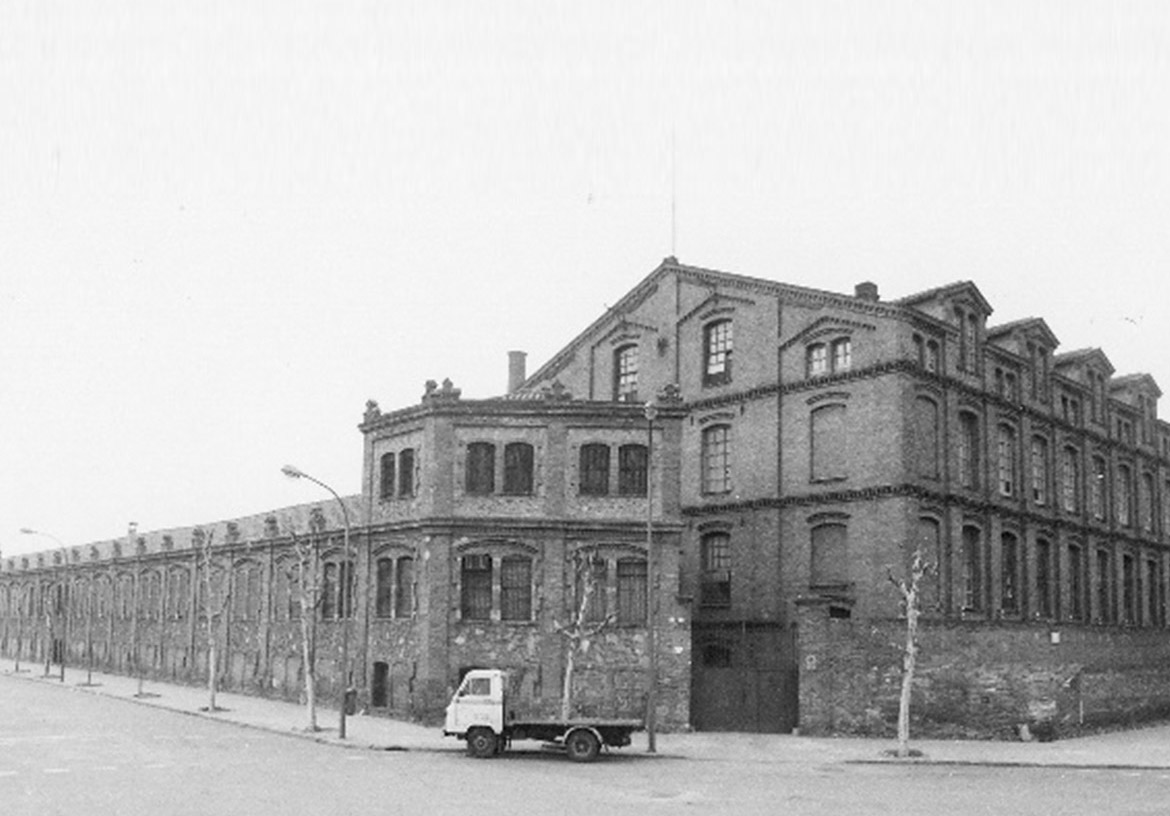
The work carried out by UPF consisted in the refurbishment of the heritage buildings La Fàbrica and La Nau, and the construction of new buildings in Carrer Roc Boronat and Carrer Tànger, the latter on the site of the former Can Framis factory, respecting the original layout of the old buildings.
The architectural complex is completed with a factory chimney, the first construction of this kind to be rehabilitated in Poblenou, and which has recovered its original purpose as a vent for gases; Plaça Gutenberg, which has become the hub of the new city block of Ca l’Aranyó; and the Tallers area, which lies within the Torre Imagina audiovisual complex belonging to the production company Mediapro, where UPF uses various technical facilities.
How does the Poblenou campus sound currently?
Bibliography consulted:
Marc Permanyer (2001), La Pompeu Fabra. La construcció d'una universitat. Quaderns Crema
Daniel Venteo (2010), Universitat Pompeu Fabra, història d'un campus urbà. Viena Edicions
